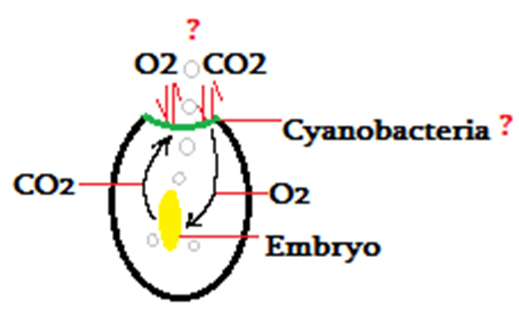Some morphological and anatomical descriptions of seed in Galanthus woronowii Losinsk. from Western Georgia
Abstract
Morphology and anatomy of seeds of Galanthus woronowii Losinsk. from Ajara and Guria (Western Georgia) regions were studied in laboratory conditions. It was found out that shape of fruits changed from round (big fruits) to longish (small fruits). Weight of mature seed was 0,0075 g. By the end of June elaiosome disappears and green hollow develops on its place. Gas bubbles were emitted from green tissues; emission was intensive in August, when embryo was already well developed. Greenness was localized mainly on cell walls. It is permissible that on cells walls located aerobic oxygenic phototrophic bacteria. In early August an embryo in seeds was well developed, reserve fat transformed to starch around of embryo. Germination of seeds began by the end September very slowly. Results of the work will be important for ex situ conservation of G. woronowii, also for expedient to plant industrial plantations.
References
Budnikov G., Kricsfalusy V. 1994. Bioecological study of Galanthus nivalis L. in the East Carpathians. Thaiszia J. Bot. 4 (1): 49–75.
Chkhaidze N., Goliadze V., Manvelidze Z., Beruashvili M., Zurabishvili M. 2013. Results of study of bulbs of Galanthus woronowii Lozinsk., spread in forests of Adjara and Guria. Current Challenges of Sustainable Forest Managment in Caucasus (Abstracts of International Scientific-Practical Conf., 7-8 October, Tbilisi, Georgia): 76. (in Georgian)
CITES 2008. Convention on international trade in endangered species of wild fauna and flora. Seventeenth Meeting of the Plants Committee, Geneva (Switzerland), 15-19 April PC17 Doc. 5.4 (Rev. 1).
Copeland L.O., McDonald M.B. 2001. Principles of seed science and technology. Kluwer Academic Publishers.
Finkelstein R.R. 2004. The role of hormone during seed development and germination. In: Davies P.J. (ed.), Plant hormones – biosynthesis, signal transduction, action. 513–537. Kluwer Academic Publishers.
Gagnidze R. 1999. Arealogical review of Colchic evergreen broad-leaved mesophyllous dendroflora species. In: Klötzli F., Walther G.R. (eds), Recent shifts in vegetation boundaries of deciduous forest, especially due to general global warming: 199–216. BirkhäuserVerlag Basel.
Gagnidze R. 2005. Vascular plants of Georgia. A nomenclatural cheklist. Tbilisi.
Kemularia-Natadze J.M. 1947. Study of Caucasian species from genus Galanthus L. Works of BIN AN GSSR 13: 24–29. (in Russian)
Kikvidze Z., Ohsawa M. 2001. Richness of Colchic vegetation: comparison between refugia of south‑western and East Asia. BioMed Central Ecology 1: 1–10.
Newtoni R.J., Hayand F.R., Ellis R.H. 2013. Seed development and maturation in early spring-flowering Galanthus nivalis and Narcissus pseudonarcissus continues post-shedding with little evidence. Ann. Bot. 111: 945–955.
Polevoi V.V. 1989. Plant Physiology. Visshaia shkola, Moscow. (in Russian)
Proskurina N., Ordzhonikidze S. 1953. Alkaloids of Galanthus woronovii. Structure of galanthine. Proc. of Acad. of Scie. of SSSR 90: 565–567.
Proskurina N., Yakovleva A., Ordzhonikidze S. 1955. Alkaloids of Galanthus woronovii. Structure of galanthamine. Zhurnal Obshchei Khimii 25: 1035–1039.
Red Book of the Georgian SSR 1982. Rare and endangered species if animals and plants. some monumets of inorganic nature. Sabchota Sakartvelo, Tbilisi. (in Georgian)
Sgenti L., Khutsishvili M. 2013. Ex-situ conservation and reproduction status for Georgia. Proceedings of the International Scientific Practical Conference degitatedthe 100th Anniversary of Batumi Botanical Garden (Batumi, Georgia, 8-10 May). Vol. 2: 84–86. (in Georgian)
Takos A.M., Rook F. 2013. Towards a molecular understanding of the biosynthesis of Amaryllidaceae alkaloids in support of their expanding medical use. Int. J. Mol. Sci. 14 (6): 11713–11741.
Zazanashvili N. 1999. On the Colkhic vegetation. In: Klötzli F., Walther G.R. (eds), Recent shifts in vegetation boundaries of deciduous forest, especially due to general global warming: 181–197. BirkhäuserVerlag Basel. (in Russian)


This work is licensed under a Creative Commons Attribution-NonCommercial-NoDerivatives 4.0 International License.
The journal is licensed by Creative Commons under BY-NC-ND license. You are welcome and free to share (copy and redistribute the material in any medium or format) all the published materials. You may not use the material for commercial purposes. You must give appropriate credit to all published materials.
The journal allow the author(s) to hold the copyrights and to retain publishing rights without any restrictions. This is also indicated at the bottom of each article.





